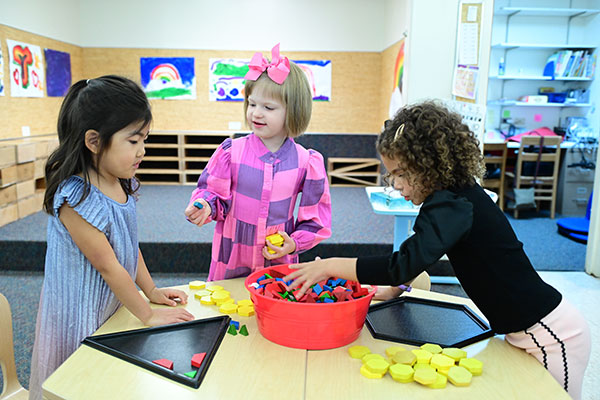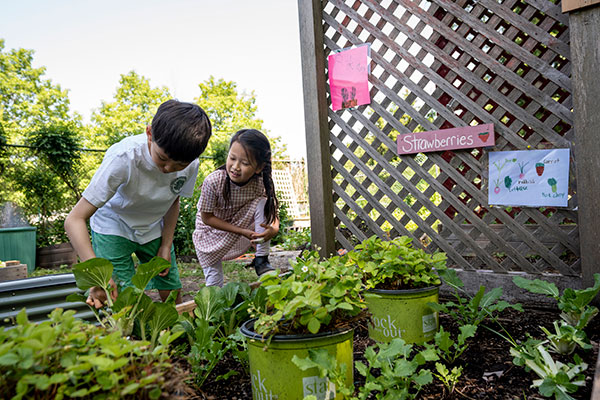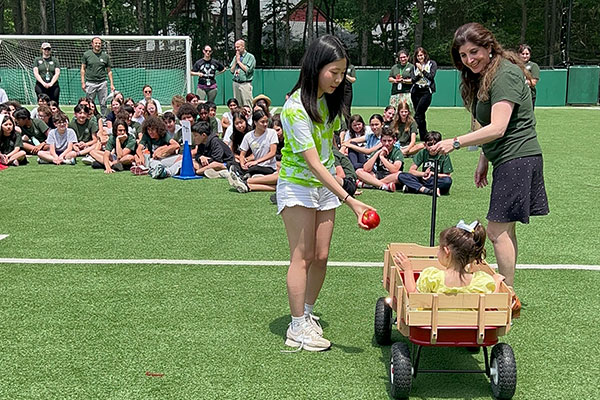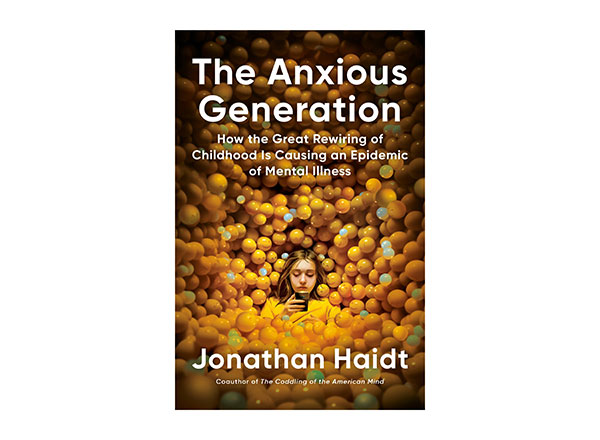Written by Sybille Bruun-Moss, Ph.D., Director of Student Success Services
This year marks my first year at EMS, and as a newcomer, I needed to more deeply understand the history of EMS in order to understand how I could best support our amazing community. On this journey, I came across a 1965 EMS spring bulletin in which readers posed the following questions: What are the pressures on our children today? Are they good or bad? Are they too great, and if so, how shall we mitigate them?
The bulletin went on to suggest that in “the mechanical world, the ‘right’ college, the good job can abet, but never replace or substitute for, the sense of values that a child grows up with.” It is remarkable to me that, 60 years later, as we contemplate our children’s futures in 2024, these questions continue to resonate so deeply within our community. While EMS has been focusing on these topics for more than half a century, new challenges have arisen as we prepare students to thrive in a distracted and divided world.
When “The Anxious Generation” by social psychologist Jonathan Haidt was published earlier this year, it addressed the essence of those very questions and found fertile ground with many groups, among them, parents and educators. And it’s not hard to understand why, as we have watched our communities, our schools — and children — change over the past few decades.
In the book, Haidt argues that the “great rewiring of childhood” (use of smartphones and the “phone-based existence”) is to blame for much of the declining mental health observed in adolescents and teens since the 2010s, bringing with it a loss of a collective sense of community as well as elusive shared values. However, controlling smartphone access is not the end of the journey, and throughout the book, Haidt delves into several other key practices that he believes are tools to help humans flourish and connect in what he terms our age of anxiety and fragmentation. Three of these practices, in particular — finding awe in nature, recognizing the resilience inherent in all children through unsupervised play and childhood independence, and the sharing of experiences — reflect areas in which EMS has centered for more than 90 years. However, as a community of educators and parents, we must continue to educate ourselves about what ails our children and discover what roles we can play in supporting them through this challenging moment in time.

THE POWER OF PLAY
According to the National Institute of Health, an estimated 5 million children aged 12 to 17 in the United States had at least one major depressive episode in 2021. That’s just over 20% — one out of every five children — of the U.S. population in this age group. However, Haidt notes that the key to supporting children now, in the midst of these distressing numbers, is to root children in real-world communities and (re)introduce them to a play-based childhood — a powerful antidote to the dependency and fragility being observed in classrooms across the country.
Haidt repeatedly celebrates the power of experiential learning, noting that a child who is given the trust and space to organically problem-solve, interact with peers and build relationships, take healthy risks, and make independent choices, will be notably more equipped to navigate challenges and experiences with confidence and resilience.
“This is very much aligned with our approach to early childhood education,” says Head of Early Learning Lauren Mactas. “Our youngest students are given daily opportunities to both autonomously and collaboratively solve problems, develop coping tools, build meaningful relationships, and find empowerment through the actualization of their infinite capabilities.”
SHAPING DIGITAL HABITS
Haidt makes recommendations in the book for schools and parents to help students maintain their inbuilt capacity for resilience by setting technology limits, including having no cellphones at school, providing no smartphones prior to high school, and allowing no social media prior to the age of 16. These “reforms,” as Haidt calls them, are not novel concepts to EMS. Associate Head of School and Director of the Arts Amelia Gold emphasizes that our school has always been phone-free for students and that we are mindful of the time kids do interdisciplinary and academic work involving a screen. “While very few students have social media in their lower school years, the impact of group text is not appropriate and interferes with their interpersonal relationships,” she says.
Starting in fourth grade, workshops for students and families are offered to discuss digital citizenship and the intricacies of interacting in the virtual world. By removing access to the ultimate tool of mass distraction — the cellphone — and prohibiting its use during the school day, students are present and in the moment, whether it be in the classroom or on the playground. In this way, we center academic growth and shared community experiences and, as Haidt states, “are likely to bring about improvement in school socializing and mental health.”

FOSTERING WONDER AND EXPLORATION
One of the three practices highlighted by Haidt — finding awe in nature — is easily accessible to our students. They explore nature trails, situated on our 14-acre campus, designated as a Certified Wildlife Habitat by the National Wildlife Federation, cultivating a deep appreciation of their surroundings. According to Haidt, spending time mindfully in nature can enhance well-being by cultivating a greater sense of purpose and reducing self-focus.
Our campus is a symphony of nature: the gentle rush of our brook, the vibrant song of a cardinal, and the budding of flowers and plants in our garden. Our natural school setting invites all our learners to explore and play while discovering the joy of nurturing growth and activates what Haidt calls the “biophilia” (love of life) response. “If we want awe and natural beauty to play a larger role in their [children’s] lives, we need to make deliberate efforts to bring them or send them to beautiful natural areas,” says Haidt.
NURTURING RESILIENCE
Haidt uses a metaphor for childhood resilience in “The Anxious Generation,” which feels poignant. While reflecting on the failed Biosphere 2 experiment in Arizona, which was constructed as a self-contained ecosystem to investigate the feasibility of supporting human life in a closed environment, with the ultimate goal of applying these findings to potential space habitats, biologist Mark Nelson noted that a lack of stress wood in the artificially created biosphere had weakened the trees, causing them to lean over. Stress wood (or reaction wood) is strong and firm wood developed over time as trees are exposed to strong winds in early life, becoming capable of withstanding environmental impacts as the trees age. In other words, the trees needed resistance to become mature, robust trees.
In children, developing this resilience is equally vital, especially if we hope to foster children with frustration tolerance, self-efficacy, and confidence. A child who experiences no setbacks or obstacles may have fewer opportunities to develop the tools with which to handle the natural challenges presented by life.
Across divisions, EMS faculty expect students to try and, at times, fail as we know that no student will always achieve their desired outcome. While always supported by teachers to learn from setbacks, EMS students are taught to see risks and failure as an opportunity to learn, understanding that experiences of small and low-stakes adversity will most often engender competence and growth. As Head of Middle School and Director of Secondary School Placement Jed Silverstein, Ph.D., says, “Our emphasis on the value of free, independent learning and play resonates with Haidt’s view that families and schools need to provide space for children to make mistakes and work through peer conflict in a way that promotes intellectual and emotional maturity.”

A COMMUNITY OF LEARNERS
Equally, the power of finding community through a collective experience is emphasized by Haidt. When EMS gathers for community celebrations, our younger students are presented with perspectives and behaviors from older students which provide both inspiration and support as relationships develop and community is forged. This mixture of exposure ensures that vulnerable young minds are presented with age-appropriate events and activities. This is especially meaningful for preteens who naturally seek ways in which to lead and model behavior, creating an environment in Morrow House of increased expectations coupled with the emotional safety of a school that culminates with eighth grade.
There is a natural progression of development in our 2s through eighth grade. While educated in separate buildings, the new tradition of handing off an apple from the oldest EMS students to the youngest EMS students at the final assembly of the school year represents the type of communal practice that allows all students to feel the rhythm of the larger community, often through singing and music. At last year’s State of the School, Head of School Marek Beck, Ph.D., noted that research findings highlight the advantage of our school model: “Children should remain children as long as possible. We want to protect childhood. And that is what we do at EMS. As parents, we know that our kids grow up fast. We keep them younger, longer.” By having three separate divisions at EMS, students are regularly able to observe behaviors that reflect their own (and adjacent) developmental levels while still being connected to the school at large.

A DEEPER DIVE
“The Anxious Generation” is not the answer to all of our societal ills, but it has captured our minds as a springboard for a burgeoning and inclusive conversation about the “attention heist” we all seem to acknowledge and about how we, as humans, have changed in time with technology and what we might have lost along the way.
While EMS is certainly already addressing many of these challenges head-on, school leadership understands that we have a responsibility to curate further conversations about these topics, with faculty, staff, students, and families. Our community read “The Anxious Generation” over the summer as a foundation from which to launch meaningful conversations. At the start
of the school year, a special community-wide brunch was planned around the book. Throughout the EMS family, we will continue to work to serve our students and find common ground in this evolving and ever-changing landscape.
There's No Better Time to Support Your Child's Education
Every time you donate to one of Elisabeth Morrow's dedicated funds, you help enrich the daily experiences of our community on campus. STEAM spaces are enhanced, library catalogs are expanded, scholarships are funded, and teachers are hired. Every day, you can see the impact your generous donations have on campus.


